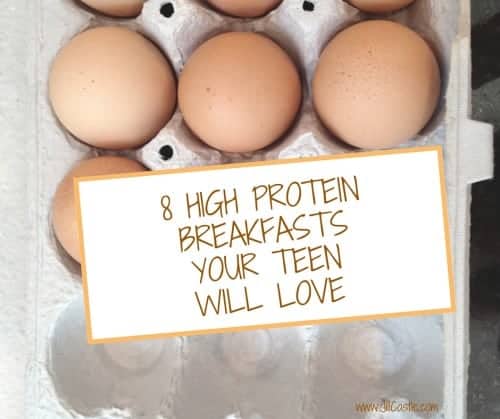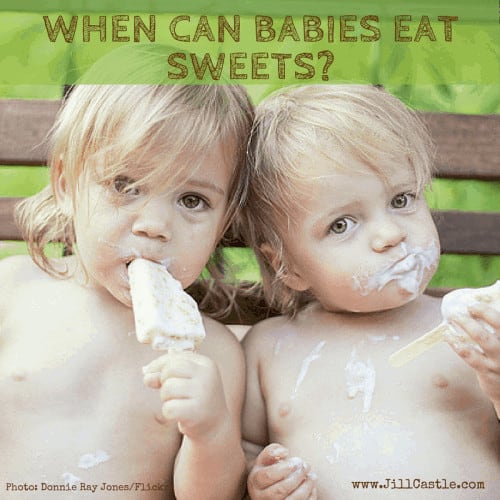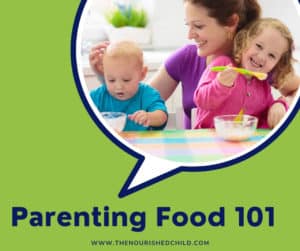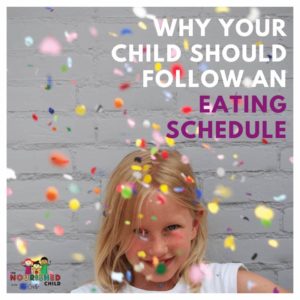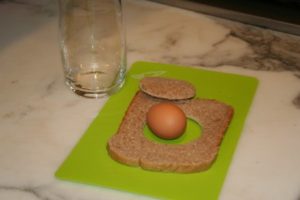Force Feeding & Food Pushing: Outcomes for Kids
September 13, 2022
Pressuring kids to take another bite, make a clean plate, and try something new are common ways parents try to get their child to eat.
Yet, force feeding, pushing food, and nagging don’t work for kids.
Learn how the clean plate club, forcing food, other parenting tactics play out and alter children’s eating.
“Make a clean plate.”
“Just take a bite.”
“Try it, you’ll like it.”
If you were a child from the ’50’s or ’60’s, these might be familiar phrases.
To be fair, we all want our kids to eat, and we want them to eat well. And we often feel it is our JOB to make sure they do.
As a childhood nutrition expert, I’ve met many parents who want to improve their kid’s eating habits, tweak the variety of foods they eat, or long for the past when little Johnny “ate everything.”
But, it’s not our job to make kids eat. Forcing kids to take more bites, clean the plate, or finish the meal before leaving the table can have negative affects down the road.
No doubt: Parent feeding is getting more complicated. Larger than life portions, convenience on every corner, and high hopes for raising healthy kids make it harder for parents to guide and govern food.
In this article, you’ll learn:
- Why parents use force feeding and pressure to eat
- The affect food pushing has on kids’ eating (both short- and long-term)
- Positive approaches to feeding kids
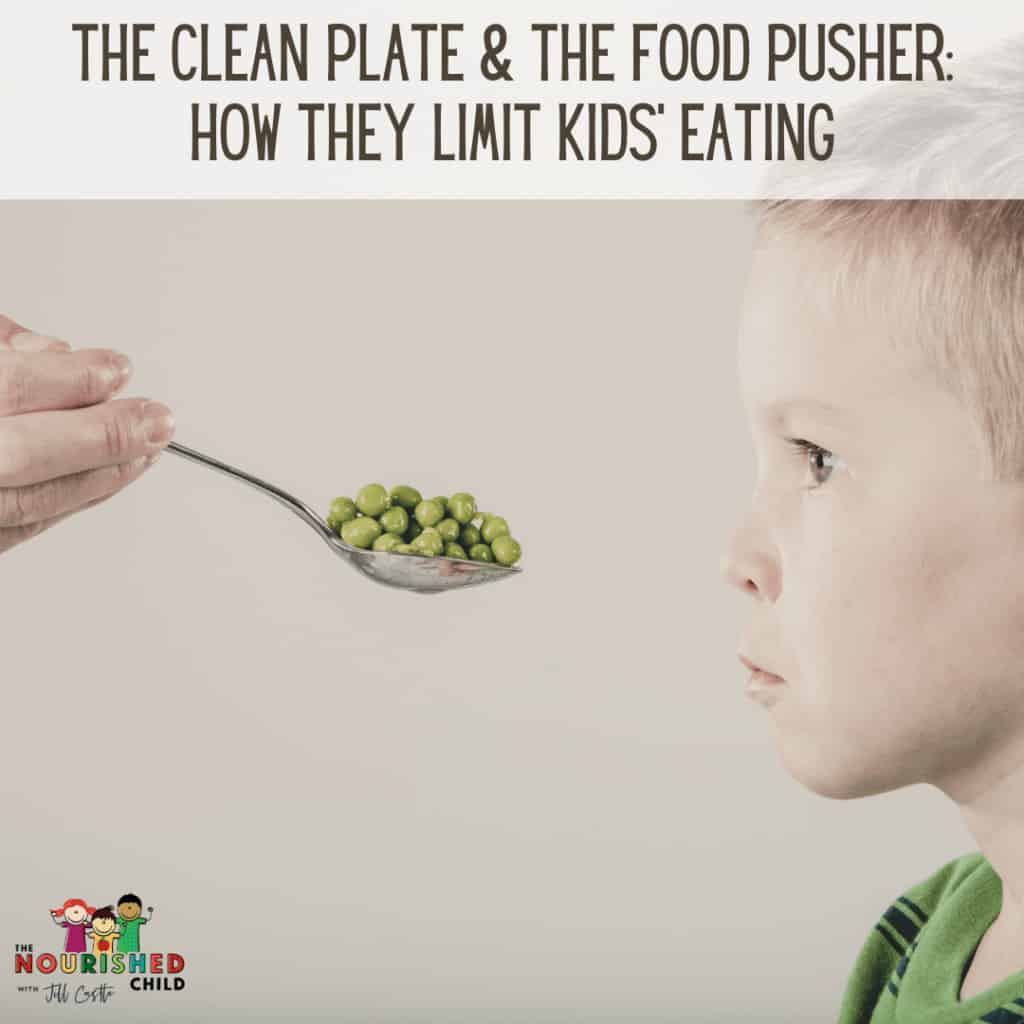
You’re Human! Getting a Child to Eat Comes Naturally
Parents have a tough time keeping it all together. They’re juggling work, kids, a personal life, and more. It’s a lot.
Making meals and snacks add to the stress. When little Johnny won’t eat, it’s hard to keep a smile on the face and a positive feeding atmosphere at the table.
In an effort to “take control” of eating and health, you may unintentionally pressure your child to eat by begging him to take another bite, try a new food, or clean his plate. You may even try forcing your child to eat.
Yes, these ideas and actions have crossed the minds of many parents, but I’m here to tell you, in the long run, they’re not very effective.
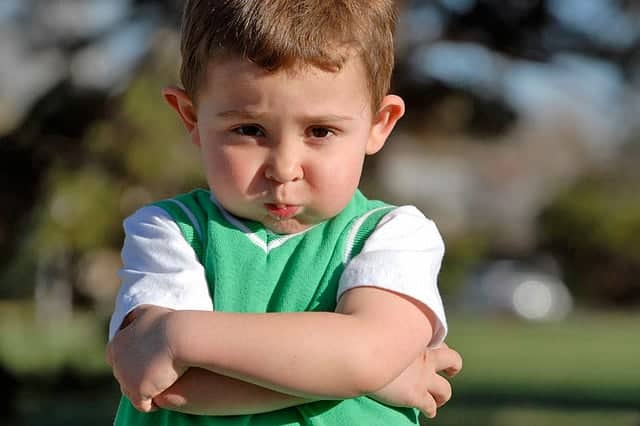
The Food Pusher
Sally had a preschooler, Ashley, who was a picky eater. Sally referred to her daughter as a “grazer.”
Ashley was busy playing, exploring and having fun. So much so, she often didn’t want to come to her toddler table for meals and wouldn’t sit for long to eat.
Concerned that she was not getting enough food, Sally found herself frequently asking Ashley if she was hungry.
She subtly left food in strategic places as little hints for Ashley to eat, such as in the playroom and the living room. When Ashley did sit to eat, Sally asked her to eat more.
She regularly nagged her to take more bites of food. Sometimes, she even forced her to eat, even though she felt awful about it.
Food pushing, forcing kids to eat, and laying on too much pressure can be counter-productive and even harmful over time.
Although Sally had the best intentions (to improve Ashley’s eating), it wasn’t getting the job done.
In fact, it was making things worse.
How the Clean Plate Club Gets Started
During toddlerhood, young children are changing developmentally. They want to be more independent and are separating from their parents.
They also become erratic eaters. Sometimes they eat well. Other times they don’t.
This irregularity in their appetite is partly due to their slowed growth, which affects the appetite.
Some toddlers refuse to eat. Or, they want the same foods over and over again.
This typical toddler development can throw parents for a loop. They’re not sure how to handle these changes, and may even launch into action.
They get overly involved in making kids eat.

The Research on Forcing Kids to Eat
Of course, forcing kids to eat is no good. It can be traumatic and implant a negative relationship with food.
You may think nagging for more bites of food, enforcing a clean plate, or pressuring your child to try something new is less harmful, but it may be just as negative, especially if it happens regularly.
Let’s break down what the child feeding research tells us.
Researchers have found that kids who are reminded to eat (called prompting) and pushed to eat more (pressuring or forcing) may indeed eat more, and perhaps, too much.
It’s been proposed by several studies that pressure to eat causes a disruption in a child’s ability to self-regulate his eating. In other words, the sense of fullness is dulled, which affects the instinct to stop eating.
Researchers postulate that poor self-regulation and Eating in the Absence of Hunger is associated with the development of unhealthy weight and childhood obesity.
However, a 2018 longitudinal study in Appetite emphasizes that it’s not just pressure to eat that may cause a disturbance in self-regulation, but it’s the intent, tone and manner by which pressure is used that may be more important.
Fussy Eaters and Pressure to Eat
On the other hand, some kids may have different experiences with pressure to eat, especially picky eaters.
A study in Appetite (2006) by researchers Galloway and Birch, found that children experienced “early satiety” (early fullness) and didn’t eat more when forced or pressured to eat more.
In other words, they ate less and/or became more picky with eating.
The researchers also showed kids may develop a dislike for foods they feel pressured to eat, like vegetables.
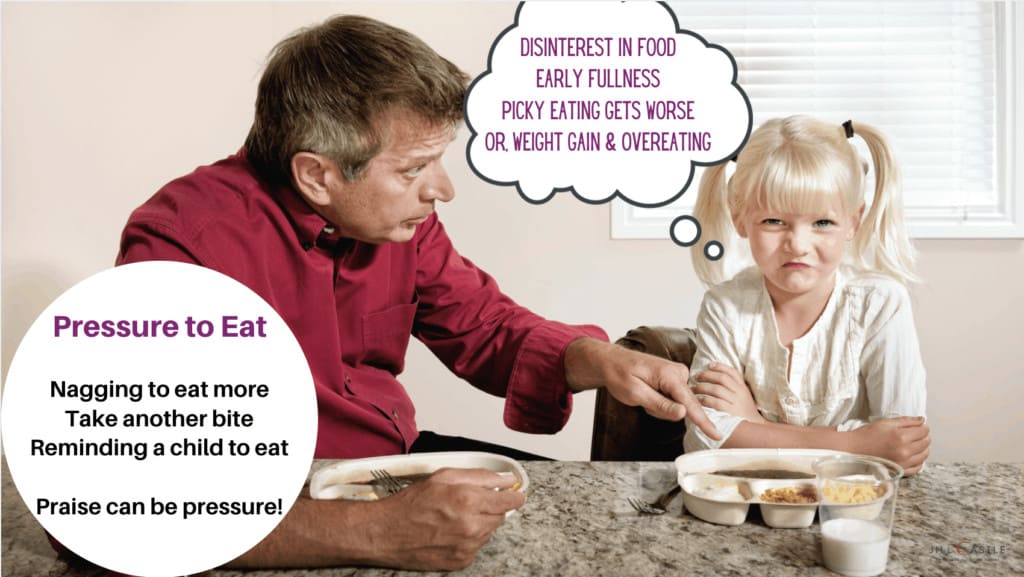
Other Effects of Forcing a Child to Eat
More recent research is exploring the type of pressure parents use, and how that influences kids’ eating.
For example, another 2018 study in Appetite showed that pressure to eat new foods was associated with Eating in the Absence of Hunger (or eating when not hungry, such as when bored or feeling emotional).
Interestingly, pressure to eat familiar foods didn’t have this affect.
Other research looks at the chicken and egg argument: Are parents pushy or are they forcing kids to eat because their kids are fussy eaters?
A 2017 study in Physiology & Behavior examined moms and young children, finding that picky eating predicted the use of pressure to eat.
In other words, parents use pressure to eat, or forcing, as a response to picky eating.
Another study in Appetite (2014) looked at 8 and 9 year old kids and the role of anxiety and the perception of pressure at the table.
They found kids with symptoms of anxiety and depression more readily perceived pressure to eat from their parents.
Last, a 2016 Appetite study of college students looked at their recollections of parental pressure to eat at the table, finding that pressure in childhood was associated with problematic eating in young adulthood.
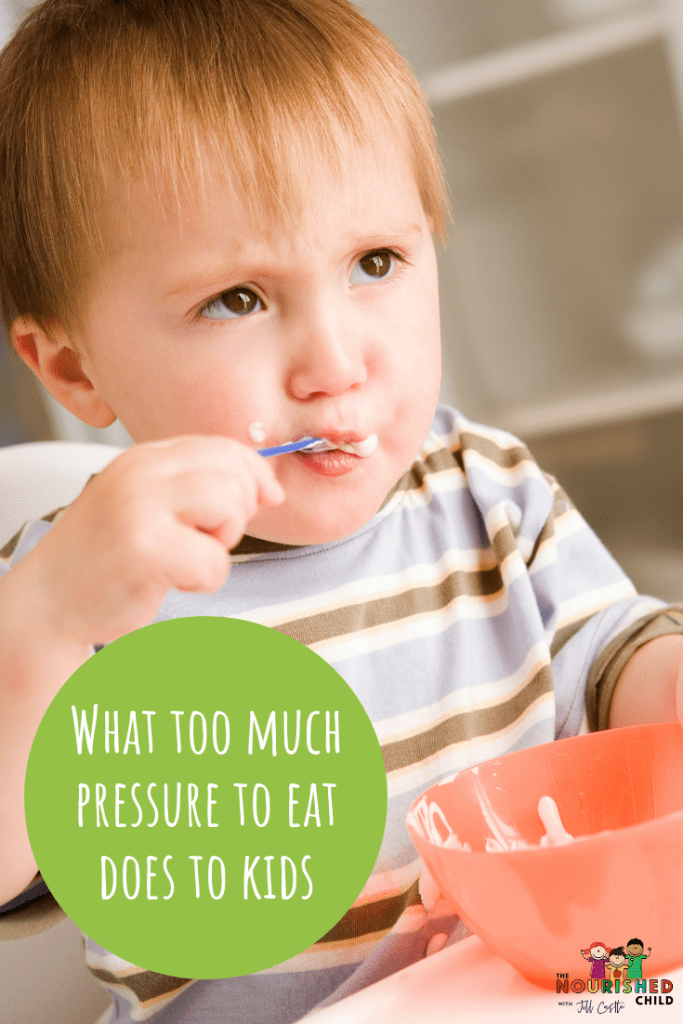
“Try It, You’ll Like It” May Backfire
It was clear Ashley was becoming less interested in food, and eating less overall. She seemed turned off by the constant availability of food, the reminders to eat, and the nudging to eat more.
More importantly, this was charging feeding triggers for Sally, setting the dynamic on a downward and negative spiral.
Sally was more and more worried about Ashley’s eating and her weight, so she pressured her more. Ashley became less and less interested in food, and was eating poorly.
Should You Force a Child to Eat?
No, we shouldn’t be forcing a child to eat food.
Would you like it if your spouse or partner forced you to eat? Made you take a bite of food? Asked you to try something new with which you weren’t comfortable?
Of course not. Our children need the same level of respect we would show a friend or family member.
Force feeding is never okay.
Use Positive Feeding Practices, Always
It’s hard to know if you’re doing harm by pressuring your child to eat, because each child is different.
Some kids may not be bothered by encouragement to eat.
Other kids may dig in their heels and be offended by pressure, or worse, force feeding.
The line between encouragement and pressure is blurry. It helps to know your child’s temperament and how he responds to these in general.
Check for a Controlling Feeding Style
Getting your child to eat can be a day-to-day feeding practice that stems from your feeding style. Over time, it can be wearing on your child, and on your relationship.
If you feel you are too involved in your child’s eating, you may want to take a step back and check your feeding style, your feeding structure (regularity of meals and snacks) and your own emotions about your child’s eating performance.
[Read: How to Create a Predictable Meal Schedule Without Being Too Controlling]
Feeding your child is one of the most important jobs of parenthood, and it’s complicated and can be difficult.
Just as it takes a childhood to cultivate a broad palate and healthy relationship with food, childhood can also be mired with nutrition challenges for parents along the way.
What Exactly is Food Pushing, Anyway?
Food pushing can be subtle prompts to eat or drink more, or it can show up as criticism of food choices, eating habits, or shaming a child to eat something you want them to.
Food pushers usually have good intent – they want a child to eat. But the outcomes for the child are typically negative.
Food pushing can damage a child’s relationship with food and self.
Your Child Should Be Able to Say No to Food
Every child needs to be able to exert their autonomy and refuse food.
It’s the only way they can stay connected to their internal appetite cues of hunger and fullness.
You should never force your child to eat food they don’t like, either. Give your child space, time and positive exposures to new foods, so they can try them on their own terms.
Need More Help with Feeding Kids?
Hang in there!
Do you force your child to eat? Or pressure him to take another bite? Or try new food? How’s that working?
Check out the next installment in this series: Food Restriction: What it Really Does to Kids and Bribing Your Child to Eat.
My workbook Try New Food: How to Help Picky Eaters Taste, Eat & Like New Foods will take you through my step-by-step system for helping your child try new food without pressure or forcing kids to eat.
Other Helpful Articles to Read about Child Eating:
How to Get a Child to Eat When He Refuses
12 Reasons Why Your Child Won’t Eat
Get Kids to Eat? That’s Not the Goal
Food Parenting: United We Should Feed
Check out my parent nutrition education website, The Nourished Child, for workshops, classes and guidebooks in nutrition and feeding.
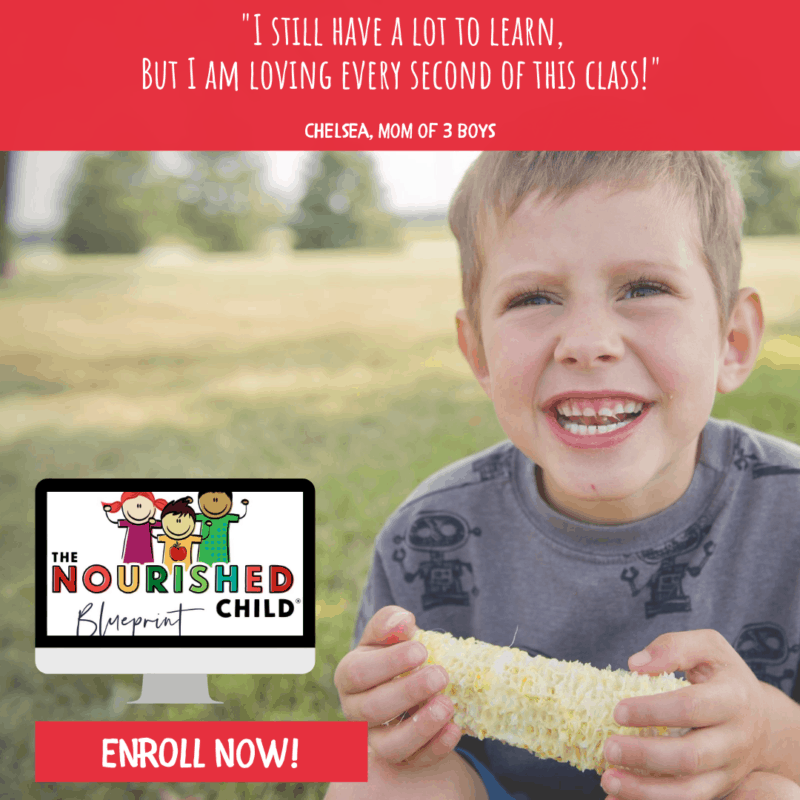

Originally published in 2013. Updated in September 2022.

